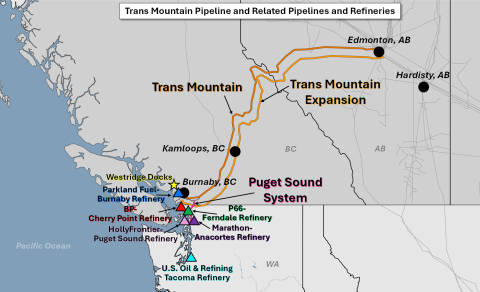It has been 12 months since the Trans Mountain Expansion Project — aka TMX — finally began operations after years of delay, creating a much-needed, larger conduit to move Western Canada’s rising crude oil production to the Pacific Northwest and overseas markets. Although the customer base for exports remains limited, the Trans Mountain pipeline system has been responsible for opening up entirely new markets for Canadian crude. As we discuss in today’s RBN blog, despite its numerous delays and immense cost, the pipeline has recently seen record crude shipments and is nearing its nameplate capacity, driven by rising exports.
It almost seems automatic as human beings to assess the progress of goals, developments and ambitions one year on from an agreed-upon starting point. After all, a lot can happen — and be learned — in the space of 12 months. More importantly, making an assessment at a one-year anniversary can also provide important guideposts for future developments while incorporating newly acquired operating knowledge to achieve new goals and avoid pitfalls as much as possible. Whether the focus is on your marriage, friendships, weight loss, enhanced fitness, or something else, one year can provide a wealth of information, some of which can be surprising and positive.
One of Canada’s most important pieces of infrastructure, TMX is celebrating a one-year anniversary since its startup in late May 2024. The primary objective of the 590-Mb/d expansion (light-orange line in Figure 1 below) was to provide a significant increase in the egress capability of crude oil from Western Canada, primarily from the oil-rich producing province of Alberta and the pipeline’s origin in Edmonton, AB, to Canada’s West Coast using an already established right-of-way provided by the original Trans Mountain Pipeline system (dark-orange line). The construction of a second parallel pipeline increased the system’s overall throughput capacity from 300 Mb/d to 890 Mb/d, which includes the capability to batch up to 50 Mb/d of refined products on the original system.
Figure 1. Trans Mountain Pipeline and Related Pipelines and Refineries. Source: RBN
Another part of the expansion involved a significant upgrading of export capacity by tanker at the terminus of the pipeline at the Westridge docks (yellow star) in Burnaby, BC, to allow for shipments of more Canadian crude by tanker to hungry buyers elsewhere in the world (see You’ve Got Another Thing Comin’, Part 2). Although this capability existed before the expansion, it was limited to just a few tankers per month, whereas the expansion now allows for the loading of six to seven tankers per week. There is also a small pre-existing spur line that runs to the Parkland refinery (blue triangle) just a few kilometers to the west of the Westridge docks. Another part of the pipeline’s network that was already in place prior to the expansion was the Puget Sound System (short pink line) that ships Canadian crude across the border to four of Washington state’s largest refiners (green, pink, purple and red triangles) just north of Seattle. This part of the system was not expanded as part of the TMX project.
Join Backstage Pass to Read Full Article









